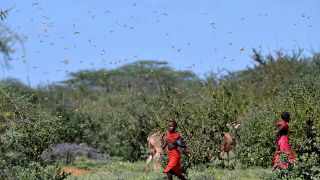Kenya
A Locust Desert Storm
The Horn of Africa, battling an unprecedented proliferation of locust crop pests for months, is facing an exacerbated food shortage threat — with crops of farmers in Turkana county, Kenya, decimated by an infestation of desert locusts. The unwelcome presence of the desert locusts is severely impacting their livelihood.
A farmer in Kalemng'orok, Lochom Ekiru, is devastated, "I am desperate, I was expecting a harvest to feed my family and take the children to school. Look at how my crops have been destroyed. Everything is gone now."
Fellow farmer, Joseph Tirkwel, echoes a similar sentiment of distress, "If the locusts had come later when the crops were ready at least I could have harvested some food for my family. That would have been more bearable. Now I don't know what to do."
A large control operation to address the situation has been launched by The Food and Agriculture Organisation of the United Nations ( FAO) with some success.
Despite the very real crisis, Tobias Takavarasha, the FAO representative in the region, remains optimistic, "I was happy to talk to the farmer, he said he will not give up. He is a farmer, he is a soldier. He needs more equipment, he needs more support for him to continue with the war to fight against hunger."
Continued Action
Hundreds of National Youth Service (NYS) volunteers have been trained in surveillance, verification and control techniques by the FAO as part of the Kenyan government’s action plan, with estimated reports of over 600,000 hectares already contained against infestation.
New sightings of immature swarms in northwest Kenya were reported by the FAO, as of mid-August.
Cool temperatures coupled with local winds have curbed the northwards migration ability of the locusts' ability to migrate northwards, leads the organisation to expect that the locusts will remain in the area until October — with the added concern of a possible resurgence of the desert locusts towards the end of the year.













00:28
Nairobi hawker shot at close range by police declared brain dead
00:48
Death toll in Kenyan anti-government protests rises to 16, says rights group
01:07
Kenya prepares for first anniversary of Finance Bill protests
01:52
UN's crucial humanitarian aid work faces a clouded future amid cuts in funds
02:00
Refugees in Kenyan camp face hunger after USAID funding freeze
01:00
Pix of the Day: June 19, 2025